Nanoporous Layer Integration for the Fabrication of ISFET and Related Transistor-Based Biosensors
Abstract
1. Introduction
2. ISFET Work Principle and Technological Challenges
2.1. From ISFET Theory to Materials Motivation
2.2. ISFET Particular Technology
3. Nanostructured Oxides Used for Sensitive Layer Integration
3.1. Porous Silicon on Si Wafer
3.2. Porous Al2O3 on Si Wafer
3.3. Nanostructured TiO2 Grown on Si Wafer
4. Other Oxides Used in ISFET and Related-Transistor Construction
5. Enzyme-FET and EGFET as Closest Relatives of ISFET
6. Discussions About Future Directions in ISFET Development
7. Conclusions
Author Contributions
Funding
Institutional Review Board Statement
Informed Consent Statement
Data Availability Statement
Conflicts of Interest
References
- Vyas, P.B.; Zhao, C.; Dag, S.; Pal, A.; Bazizi, E.M.; Ayyagari-Sangamalli, A. Next Generation Gate-all-around Device Design for Continued Scaling Beyond 2 nm Logic. In Proceedings of the International Conference on Simulation of Semiconductor Processes and Devices (SISPAD), Kobe, Japan, 27–29 September 2023; pp. 57–60. [Google Scholar] [CrossRef]
- Refai-Ahmed, G.; Zhirnov, V.V.; Park, S.B.; Helmy, A.S.; Sammakia, B.; Ghose, K.; Ang, J.A.; Bonilla, G.; Mahdi, T.; Wieser, J.; et al. New Roadmap for Microelectronics: Charting the Semiconductor Industry’s Path Over the Next 5, 10, and 20 Years. In Proceedings of the 2024 IEEE 26th Electronics Packaging Technology Conference (EPTC), Singapore, 3–6 December 2024; pp. 1260–1266. [Google Scholar] [CrossRef]
- Panahi, A.; Ghafar-Zadeh, E. Emerging Field-Effect Transistor Biosensors for Life Science Applications. Bioengineering 2023, 10, 793. [Google Scholar] [CrossRef]
- Ravariu, C. Current Status of Field-Effect Transistors for Biosensing Applications. Biosensors 2022, 12, 1081. [Google Scholar] [CrossRef]
- Rai, H.; Singh, K.R.B.; Natarajan, A.; Pandey, S.S. Advances in field effect transistor based electronic devices integrated with CMOS technology for biosensing. Talanta Open 2025, 11, 100394. [Google Scholar] [CrossRef]
- Yang, J.; Yu, C. Chapter 1—Fundamentals of chemical sensors and biosensors. In Machine Learning and Artificial Intelligence in Chemical and Biological Sensing; Yoon, J.-Y., Yu, C., Eds.; Elsevier Science: Amsterdam, The Netherlands, 2024; pp. 1–21. [Google Scholar] [CrossRef]
- Musala, S.; Srinivasulu, A.; Appasani, B.; Ravariu, C. Low Power High Speed FINFET Based Differential Adder Circuits with Proposed Carry/Carrybar Structures. Univ. Politeh. Buchar. Sci. Bull. Ser. C Electr. Eng. Comput. Sci. 2023, 85, 335–353. [Google Scholar]
- Ravariu, C.; Srinivasulu, A.; Mihaiescu, D.E.; Musala, S. Generalized Analytical Model for Enzymatic BioFET Transistors. Biosensors 2022, 12, 474. [Google Scholar] [CrossRef]
- Butt, M.A.; Piramidowicz, R. Integrated Photonic Sensors for the Detection of Toxic Gasses—A Review. Chemosensors 2024, 12, 143. [Google Scholar] [CrossRef]
- Lee, J.; Lu, A.; Li, W.; Yu, S. NeuroSim V1.4: Extending Technology Support for Digital Compute-in-Memory Toward 1nm Node. IEEE Trans. Circuits Syst. I Regul. Pap. 2024, 71, 1733–1744. [Google Scholar] [CrossRef]
- Boughedda, A.; Pancheri, L.; Parmesan, L.; Gasparini, L.; Quarta, G.; Perenzoni, D.; Perenzoni, M. The Modeling of a Single-Electron Bipolar Avalanche Transistor in 150 nm CMOS. Sensors 2025, 25, 3354. [Google Scholar] [CrossRef]
- Gubanova, O.; Poletaev, A.; Komarova, N.; Grudtsov, V.; Ryazantsev, D.; Shustinskiy, M.; Shibalov, M.A.; Kuznetsov, A. A novel extended gate ISFET design for biosensing application compatible with standard CMOS. Mater. Sci. Semicond. Process. 2024, 177, 108387. [Google Scholar] [CrossRef]
- Ravariu, C.; Mihaiescu, D.; Morosan, A.; Vasile, B.S.; Purcareanu, B. Sulpho-Salicylic Acid Grafted to Ferrite Nanoparticles for n-Type Organic Semiconductors. Nanomaterials 2020, 10, 1787. [Google Scholar] [CrossRef] [PubMed]
- Kamani, T.; Baz, A.; Patel, S.K. Design of an Efficient Surface Plasmon Resonance Biosensor for Label-Free Detection of Blood Components. Plasmonics 2025, 20, 3147–3160. [Google Scholar] [CrossRef]
- Olajiga, O.M.; Jameson, S.B.; Carter, B.H.; Wesson, D.M.; Mitzel, D.; Londono-Renteria, B. Artificial Feeding Systems for Vector-Borne Disease Studies. Biology 2024, 13, 188. [Google Scholar] [CrossRef]
- Eidi, A. Design and evaluation of an implantable MEMS based biosensor for blood analysis and real-time measurement. Microsyst. Technol. 2023, 29, 857–864. [Google Scholar] [CrossRef]
- Yáñez, C.; DeMas-Giménez, G.; Royo, S. Overview of Biofluids and Flow Sensing Techniques Applied in Clinical Practice. Sensors 2022, 22, 6836. [Google Scholar] [CrossRef] [PubMed]
- Pelenis, D.; Barauskas, D.; Dzikaras, M.; Viržonis, D. Four-Channel Ultrasonic Sensor for Bulk Liquid and Biochemical Surface Interrogation. Biosensors 2024, 14, 66. [Google Scholar] [CrossRef] [PubMed]
- Leau, S.A.; Diaconu, I.; Lete, C.; Matei, C.; Lupu, S. Electro analysis of serotonin at platinum nanoparticles modified electrode. Univ. Politeh. Buchar. Sci. Bull. Ser. C Electr. Eng. Comput. Sci. 2024, 86, 3–14. [Google Scholar]
- Kamal Eddin, F.B.; Fen, Y.W. The Principle of Nanomaterials Based Surface Plasmon Resonance Biosensors and Its Potential for Dopamine Detection. Molecules 2020, 25, 2769. [Google Scholar] [CrossRef]
- Ravariu, C.; Popescu, A.; Podaru, C.; Manea, E.; Babarada, F. The Nanopous Al2O3 Material Used for the Enzyme Entrapping in a Glucose Biosensor. In Proceedings of the XII Mediterranean Conference on Medical and Biological Engineering and Computing MEDICON, Chalkidiki, Greece, 27–30 May 2010; Springer: Berlin/Heidelberg, Germany, 2010; Volume 29, pp. 459–462. [Google Scholar]
- Ryazantsev, D.; Shustinskiy, M.; Sheshil, A.; Titov, A.; Grudtsov, V.; Vechorko, V.; Kitiashvili, I.; Puchnin, K.; Kuznetsov, A.; Komarova, N. A Portable Readout System for Biomarker Detection with Aptamer-Modified CMOS ISFET Array. Sensors 2024, 24, 3008. [Google Scholar] [CrossRef]
- Ravariu, C.; Podaru, C.; Manea, E. Design and technological characterization aspects of a gluco-detector BioFET. In Proceedings of the 2009 International Semiconductor Conference, Sinaia, Romania, 12–14 October 2009; pp. 281–284. [Google Scholar] [CrossRef]
- Minamiki, T.; Sekine, T.; Aiko, M.; Su, S.; Minami, T. An organic FET with an aluminum oxide extended gate for pH sensing. Sens. Mater. 2019, 31, 99–106. [Google Scholar] [CrossRef]
- Pushparaj, K.; Di Zazzo, L.; Allegra, V.; Capuano, R.; Catini, A.; Magna, G.; Paolesse, R.; Di Natale, C. Detection of Ascorbic Acid in Tears with an Extended-Gate Field-Effect Transistor-Based Electronic Tongue Made of Electropolymerized Porphyrinoids on Laser-Induced Graphene Electrodes. Chemosensors 2025, 13, 108. [Google Scholar] [CrossRef]
- Abhinav, V.; Naik, T.R. Low-Cost, Point-of-Care Potassium Ion Sensing Electrode in EGFET Configuration for Ultra-High Sensitivity. IEEE Access 2024, 12, 121837–121845. [Google Scholar] [CrossRef]
- Pullano, S.A.; Critello, C.D.; Mahbub, I.; Tasneem, N.T.; Shamsir, S.; Islam, S.K.; Greco, M.; Fiorillo, A.S. EGFET-Based Sensors for Bioanalytical Applications: A Review. Sensors 2018, 18, 4042. [Google Scholar] [CrossRef]
- Hashim, S.B.; Aqilah Azlan, N.; Mahzan, N.H.; Zulkifli, Z.; Zulkefle, M.A.; Herman, S.H. Understanding the Extended-gate FET pH Sensor Sensing Mechanism through Equivalent Circuit Simulation in LTSpice. In Proceedings of the 2024 IEEE International Conference on Automatic Control and Intelligent Systems (I2CACIS), Shah Alam, Malaysia, 29 June 2024; pp. 373–378. [Google Scholar] [CrossRef]
- Pan, T.M.; Lin, L.-A.; Ding, H.-Y.; Her, J.-L.; Pang, S.-T. A simple and highly sensitive flexible sensor with extended-gate field-effect transistor for epinephrine detection utilizing InZnSnO sensing films. Talanta 2024, 275, 126178. [Google Scholar] [CrossRef]
- Zheng, A.L.T.; Teo, E.Y.L.; Seenivasagam, S.; Hung, Y.P.; Boonyuen, S.; Chung, E.L.T.; Lease, J.; Andou, Y. Nanostructures embedded on porous materials for the catalytic reduction of nitrophenols: A concise review. J. Porous Mater. 2024, 31, 1557–1575. [Google Scholar] [CrossRef]
- Feng, S.; Luo, Q.; Song, X. An antibody nanopore-enabled microsensor for detection of osteoprotegerin. Jpn. J. Appl. Phys. 2024, 63, 117001. [Google Scholar] [CrossRef]
- McBride, S.A.; Temprano-Coleto, F.; Kaneelil, P.R.; Knopp, R.; Taylor, A.J.; Storey-Matsutani, M.A.; Wilson, J.L.; Saleh, M.S.; Konicek, A.R. Effect of capillary number and viscosity ratio on multiphase displacement in microscale pores. Phys. Rev. Fluids 2025, 10, 054201. [Google Scholar] [CrossRef]
- Lee, M.; Lee, M.; Kim, S.; Park, N. Stimuli-Responsive DNA Hydrogel Design Strategies for Biomedical Applications. Biosensors 2025, 15, 355. [Google Scholar] [CrossRef]
- Shahid, Z.; Veenuttranon, K.; Lu, X.; Chen, J. Recent Advances in the Fabrication and Application of Electrochemical Paper-Based Analytical Devices. Biosensors 2024, 14, 561. [Google Scholar] [CrossRef]
- Shahbaz, A.; Hussain, N.; Intisar, A. Immobilized Enzymes-Based Biosensing Cues for Strengthening Biocatalysis and Biorecognition. Catal. Lett. 2022, 152, 2637–2649. [Google Scholar] [CrossRef]
- Ravariu, C.; Manea, E.; Parvulescu, C.; Babarada, F.; Popescu, A. Titanium dioxide nanotubes on silicon wafer designated for GOX enzymes immobilization. Dig. J. Nanomater. Biostructures 2011, 6, 703–707. [Google Scholar]
- Wang, B.; Zhang, J.; Dong, S. Silica sol–gel composite film as an encapsulation matrix for the construction of an amperometric tyrosinase-based biosensor. Biosens. Bioelectron. 2000, 15, 397–402. [Google Scholar] [CrossRef] [PubMed]
- Gupta, R.; Chaudhury, N.K. Entrapment of biomolecules in sol–gel matrix for applications in biosensors: Problems and future prospects. Biosens. Bioelectron. 2007, 22, 2387–2399. [Google Scholar] [CrossRef]
- Ravariu, C.; Parvulescu, C.C.; Manea, E.; Tucureanu, V. Optimized Technologies for Cointegration of MOS ransistor and Glucose Oxidase Enzyme on a Si-Wafer. Biosensors 2021, 11, 497. [Google Scholar] [CrossRef]
- Roelofs, K.G.; Wang, J.; Sintim, H.O.; Leea, V.T. Differential radial capillary action of ligand assay for high-throughput detection of protein-metabolite interactions. Proc. Natl. Acad. Sci. USA 2011, 108, 15528–15533. [Google Scholar] [CrossRef]
- Chen, S.-J.; Lu, S.-Y.; Tseng, C.-C.; Huang, K.-H.; Chen, T.-L.; Fu, L.-M. Rapid Microfluidic Immuno-Biosensor Detection System for the Point-of-Care Determination of High-Sensitivity Urinary C-Reactive Protein. Biosensors 2024, 14, 283. [Google Scholar] [CrossRef]
- Mah, D.-G.; Oh, S.-M.; Jung, J.; Cho, W.-J. Enhancement of Ion-Sensitive Field-Effect Transistors through Sol-Gel Processed Lead Zirconate Titanate Ferroelectric Film Integration and Coplanar Gate Sensing Paradigm. Chemosensors 2024, 12, 134. [Google Scholar] [CrossRef]
- Prall, K. Mobile Ion Contamination. In CMOS Plasma and Process Damage; Springer: Cham, Switzerland, 2025; pp. 389–434. [Google Scholar] [CrossRef]
- Yeh, J.-T.; Hsiao, C.-Y.; Lee, H.-W.; Kuo, C.-F. Comparison between Different Configurations of Reference Electrodes for an Extended-Gate Field-Effect Transistor pH Sensor. ACS Omega 2025, 10, 8433–8439. [Google Scholar] [CrossRef]
- Bharathi, G.; Hong, S. Gate Engineering in Two-Dimensional (2D) Channel FET Chemical Sensors: A Comprehensive Review of Architectures, Mechanisms and Materials. Chemosensors 2025, 13, 217. [Google Scholar] [CrossRef]
- Hu, W.-P.; Yang, Y.-Q.; Lee, C.-H.; Vu, C.-A.; Chen, W.-Y. Comparing solution-gate and bottom-gate nanowire field-effect transistors on pH sensing with different salt concentrations and surface modifications. Talanta 2024, 271, 125731. [Google Scholar] [CrossRef] [PubMed]
- Garika, V.; Babbar, S.; Samanta, S.; Harilal, S.; Lerner, A.E.; Rotfogel, Z.; Pikhay, E.; Shehter, I.; Elkayam, A.; Bashouti, M.Y.; et al. Addressing the challenge of solution gating in biosensors based on field-effect transistors. Biosens. Bioelectron. 2024, 265, 116689. [Google Scholar] [CrossRef] [PubMed]
- Bergveld, P. Development, operation and application of the ion sensitive field effect transistor as a tool for electrophysiology. IEEE Trans. Biomed. Eng. BME 1972, 19, 342–351. [Google Scholar] [CrossRef]
- Janićijević, Ž.; Baraban, L. Integration Strategies and Formats in Field-Effect Transistor Chemo- and Biosensors: A Critical Review. ACS Sens. 2025, 10, 2431–2452. [Google Scholar] [CrossRef] [PubMed]
- Mansouri, S.; Alharbi, Y.; Alqahtani, A. Nanomaterials Connected to Bioreceptors to Introduce Efficient Biosensing Strategy for Diagnosis of the TORCH Infections: A Critical Review. Crit. Rev. Anal. Chem. 2024, 55, 603–620. [Google Scholar] [CrossRef]
- Bergveld, P. Thirty years of ISFETOLOGY What happened in the past 30 years and what may happen in the next 30 years. Sens. Actuators B 2003, 88, 1–20. [Google Scholar] [CrossRef]
- Ravariu, C. MOSFET with Tips and Tricks; e-Book Politehnica Press Publisher: Bucharest, Romania, 2023; pp. 56–59. [Google Scholar]
- van Hal, R.E.G.; Eijkel, J.C.T.; Bergveld, P. A novel description of ISFET sensitivity with the buffer capacity and double layer capacitance as key parameters. Sens. Actuators B 1995, 24–25, 201–205. [Google Scholar] [CrossRef]
- Esashi, M.; Matsuo, T. Integrated micro multi ion sensor using field effect of semiconductor. IEEE Trans. Biomed. Eng. BME 1978, 25, 184–192. [Google Scholar] [CrossRef]
- Sakai, T. Ion sensitive FET with a silicon–insulator silicon structure. Proc. Transducer 1987, 87, 711–714. [Google Scholar]
- Hyun, T.-H.; Cho, W.-J. High-Performance FET-Based Dopamine-Sensitive Biosensor Platform Based on SOI Substrate. Biosensors 2023, 13, 516. [Google Scholar] [CrossRef] [PubMed]
- Chovelon, J.M.; Jaffrezic-Renault, N.; Cros, Y.; Fombon, J.J.; Pedone, D. Monitoring of ISFET encapsulation aging by impedance measurements. Sens. Actuators B Chem. 1991, 3, 43–50. [Google Scholar] [CrossRef]
- Nandanwar, S.; Lee, S.; Park, M.; Kim, H.J. Label-Free Extended Gate Field-Effect Transistor for Sensing Microcystin-LR in Freshwater Samples. Sensors 2025, 25, 1587. [Google Scholar] [CrossRef] [PubMed]
- Popescu, M.; Ravariu, C.; Hascsi, Z. First and Second Order Digital Circuits with Neuronal Models under Pulses Train Stimulus. Rom. J. Inf. Sci. Technol. 2025, 28, 223–232. [Google Scholar] [CrossRef]
- Hoover, T.M. Development of macroporous silicon for bio-chemical sensing applications. J. Microelectron. Eng. Conf. 2005, 15, 17. [Google Scholar]
- Manea, E.; Podaru, C.; Popescu, A.; Budianu, E.; Purica, M.; Babarada, F.; Parvulescu, C. Nano-Porous Silicon for Sensors and Solar Cells. AIP Conf. Proc. 2007, 899, 759. [Google Scholar] [CrossRef]
- Zavatski, S.; Popov, A.I.; Chemenev, A.; Dauletbekova, A.; Bandarenka, H. Wet Chemical Synthesis and Characterization of Au Coatings on Meso- and Macroporous Si for Molecular Analysis by SERS Spectroscopy. Crystals 2022, 12, 1656. [Google Scholar] [CrossRef]
- Ramírez-González, F.; García-Salgado, G.; Rosendo, E.; Díaz, T.; Nieto-Caballero, F.; Coyopol, A.; Romano, R.; Luna, A.; Monfil, K.; Gastellou, E. Porous Silicon Gas Sensors: The Role of the Layer Thickness and the Silicon Conductivity. Sensors 2020, 20, 4942. [Google Scholar] [CrossRef] [PubMed]
- Lu, H.; Jin, M.; Zhang, Z.; Wu, S.; Shui, L. Wafer-Scale Fabrication and Transfer of Porous Silicon Films as Flexible Nanomaterials for Sensing Application. Nanomaterials 2022, 12, 1191. [Google Scholar] [CrossRef]
- Gonzalez-Rodriguez, R.; Hathaway, E.; Coffer, J.L.; del Castillo, R.M.; Lin, Y.; Cui, J. Gold Nanoparticles in Porous Silicon Nanotubes for Glucose Detection. Chemosensors 2024, 12, 63. [Google Scholar] [CrossRef]
- Jin, B.; Liao, L.; Shen, X.; Mei, Z.; Du, Q.; Liang, L.; Lei, B.; Du, J. Advancement in Research on Silicon/Carbon Composite Anode Materials for Lithium-Ion Batteries. Metals 2025, 15, 386. [Google Scholar] [CrossRef]
- Awawdeh, K.; Buttkewitz, M.A.; Bahnemann, J.; Segal, E. Enhancing the performance of porous silicon biosensors: The interplay of nanostructure design and microfluidic integration. Microsyst. Nanoeng. 2024, 10, 100. [Google Scholar] [CrossRef]
- Kaczmarek, K.A.; Kosewski, G.; Dobrzyńska, M.; Drzymała-Czyż, S. Lactoferrin Production: A Systematic Review of the Latest Analytical Methods. Appl. Sci. 2025, 15, 4540. [Google Scholar] [CrossRef]
- Babarada, F.; Ravariu, C.; Bajenaru, A.; Manea, E. From simulations to masks for a BioFET design. In Proceedings of the CAS 2010 Proceedings (International Semiconductor Conference), Sinaia, Romania, 11–13 October 2010; pp. 479–482. [Google Scholar] [CrossRef]
- Sen, A.; Shim, J.; Bala, A.; Park, H.; Kim, S. Boosting Sensitivity and Reliability in Field-Effect Transistor-Based Biosensors with Nanoporous MoS2 Encapsulated by Non-Planar Al2O3. Adv. Funct. Mater. 2023, 33, 2301919. [Google Scholar] [CrossRef]
- Khanna, V.K. A plausible ISFET drift-like aging mechanism for Al2O3 humidity sensor. Sens. Actuators B Chem. 2015, 213, 351–359. [Google Scholar] [CrossRef]
- Hassan, E.A.; Abdolkader, T.M. A review of ion-sensitive field effect transistor (ISFET) based biosensors. Int. J. Mater. Technol. Innov. 2023, 3, 69–84. [Google Scholar] [CrossRef]
- Prem, A.R.; Elshafie, H.; Changalasetty, S.B.; Mubarakali, A. Optimizing Thermal Characteristics and Mobility in Sub-10 nm β-(AlxGa1–x)2O3/Ga2O3 Tri-Metal MODFETs for Advanced Biosensing Applications. ECS J. Solid State Sci. Technol. 2025, 14, 017005. [Google Scholar] [CrossRef]
- Deeban, Y. Effectiveness of CAD-CAM Milled Versus DMLS Titanium Frameworks for Hybrid Denture Prosthesis: A Narrative Review. J. Funct. Biomater 2024, 15, 376. [Google Scholar] [CrossRef] [PubMed]
- Marin, E.; Lanzutti, A. Biomedical Applications of Titanium Alloys: A Comprehensive Review. Materials 2024, 17, 114. [Google Scholar] [CrossRef] [PubMed]
- Ravariu, C.; Manea, E.; Babarada, F. Masks and metallic electrodes compounds for silicon biosensor integration. J. Alloys Compd. 2017, 697, 72–79. [Google Scholar] [CrossRef]
- Yang, D.-J.; Kim, H.-G.; Cho, S.-J.; Choi, W.-I. Thickness-conversion ratio from titanium to TiO2 nanotube fabricated by anodization method. Mater. Lett. 2008, 62, 775–779. [Google Scholar] [CrossRef]
- Yang, C.-C.; Chen, K.-Y.; Su, Y.-K. TiO2 Nano Flowers Based EGFET Sensor for pH Sensing. Coatings 2019, 9, 251. [Google Scholar] [CrossRef]
- Zulkefle, M.A.; Rahman, R.A.; Rusop, M.; Abdullah, W.F.H.; Herman, S.H. Porous TiO2 thin film for EGFET pHsensing application. Int. J. Eng. Technol. 2018, 7, 112–114. [Google Scholar] [CrossRef]
- Ravariu, C.; Manea, E.; Pârvulescu, C.; Țucureanu, V.; Appasani, B.; Srinivasulu, A. Preliminary simulations and experiments of enzymatic MOS biosensors. In Proceedings of the 2024 International Semiconductor Conference (CAS), Sinaia, Romania, 9–11 October 2024; pp. 301–304. [Google Scholar] [CrossRef]
- Ali, G.M. Interdigitated extended gate field effect transistor without reference electrode. J. Electron. Mater. 2017, 46, 713–717. [Google Scholar] [CrossRef]
- Qi, J.; Zhang, H.; Ji, Z.; Xu, M.; Zhang, Y. ZnO nano-array-based EGFET biosensor for glucose detection. Appl. Phys. A 2015, 119, 807–811. [Google Scholar] [CrossRef]
- Guerra, E.M.; Mulato, M. Synthesis and characterization of vanadium oxide/hexadecylamine membrane and its application as pH-EGFET sensor. J. Sol-Gel Sci. Technol. 2009, 52, 315–320. [Google Scholar] [CrossRef]
- Jrar, J.A.; Bilal, M.; Butt, F.K.; Zhang, Z.; Din, A.U.; Hou, J. A novel 2D graphene oxide/manganese vanadium oxide nanocomposite-based PEC biosensor for selective detection of glucose. J. Alloys Compd. 2025, 1021, 179595. [Google Scholar] [CrossRef]
- Yang, C.M.; Wei, C.-H.; Ughi, F.; Chang, J.-Y.; Pijanowska, D.G.; Lai, C.-S. High pH stability and detection of α-synuclein using an EGFET biosensor with an HfO2 gate deposited by high-power pulsed magnetron sputtering. Sens. Actuators B Chem. 2024, 416, 136006. [Google Scholar] [CrossRef]
- Kim, J.; Seung Rim, Y.; Chen, H.; Cao, H.H.; Nakatsuka, N.; Hinton, H.L.; Zhao, C.; Andrews, A.M.; Yang, Y.; Weiss, P.S. Fabrication of High-Performance Ultrathin In2O3 Film Field-Effect Transistors and Biosensors Using Chemical Lift-Off Lithography. ACS Nano 2015, 9, 4572–4582. [Google Scholar] [CrossRef]
- Tang, T.; Liu, X.; Li, C.; Lei, B.; Zhang, D.; Rouhanizadeh, M.; Hsiai, T.; Zhou, C. Complementary Response of In2O3 Nanowires and Carbon Nanotubes to Low-Density Lipoprotein Chemical Gating. Appl. Phys. Lett. 2005, 86, 103903. [Google Scholar] [CrossRef]
- Curreli, M.; Li, C.; Sun, Y.; Lei, B.; Gundersen, M.A.; Thompson, M.E.; Zhou, C. Selective Functionalization of In2O3 Nanowire Material Devices for Biosensing Applications. J. Am. Chem. Soc. 2005, 127, 6922–6923. [Google Scholar] [CrossRef] [PubMed]
- Elkington, D.; Cooling, N.; Belcher, W.; Dastoor, P.C.; Zhou, X. Organic Thin-Film Transistor (OTFT)-Based Sensors. Electronics 2014, 3, 234–254. [Google Scholar] [CrossRef]
- Ravariu, C.; Istrati, D.; Mihaiescu, D.; Morosan, A.; Purcareanu, B.; Cristescu, R.; Trusca, R.; Vasile, B. Solution for green organic thin film transistors: Fe3O4 nano-core with PABA external shell as p-type film. J. Mater. Sci. Mater. Electron. 2020, 31, 3063–3073. [Google Scholar] [CrossRef]
- Xiang, Z.; Wang, K.; Lu, J.; Wang, Z.; Jin, H.; Li, R.; Shi, M.; Wu, L.; Yan, F.; Jiang, R. Uniform Oxide Layer Integration in Amorphous IGZO Thin Film Transistors for Enhanced Multilevel-Cell NAND Memory Performance. Appl. Sci. 2024, 14, 2588. [Google Scholar] [CrossRef]
- Liu, J.; Xiong, X.; Li, H.; Huang, X.; Wang, Y.; Sheng, Y.; Liang, Z.; Yao, R.; Ning, H.; Wei, X. Application of Solution-Processed High-Entropy Metal Oxide Dielectric Layers with High Dielectric Constant and Wide Bandgap in Thin-Film Transistors. Micromachines 2024, 15, 1465. [Google Scholar] [CrossRef] [PubMed]
- Alam, F.; Ashfaq Ahmed, M.; Jalal, A.H.; Siddiquee, I.; Adury, R.Z.; Hossain, G.M.M.; Pala, N. Recent Progress and Challenges of Implantable Biodegradable Biosensors. Micromachines 2024, 15, 475. [Google Scholar] [CrossRef]
- Kosri, E.; Ibrahim, F.; Thiha, A.; Madou, M. Micro and Nano Interdigitated Electrode Array (IDEA)-Based MEMS/NEMS as Electrochemical Transducers: A Review. Nanomaterials 2022, 12, 4171. [Google Scholar] [CrossRef]
- Kuanaeva, R.M.; Vaneev, A.N.; Gorelkin, P.V.; Erofeev, A.S. Nanopipettes as a Potential Diagnostic Tool for Selective Nanopore Detection of Biomolecules. Biosensors 2024, 14, 627. [Google Scholar] [CrossRef]
- Qian, J.; Tan, R.; Feng, M.; Shen, W.; Lv, D.; Song, W. Humidity Sensing Using Polymers: A Critical Review of Current Technologies and Emerging Trends. Chemosensors 2024, 12, 230. [Google Scholar] [CrossRef]
- Lee, M.; Kim, S.H.; Kim, D.; Kim, H.J. Rapid and Easy Detection of Microcystin-LR Using a Bioactivated Multi-Walled Carbon Nanotube-Based Field-Effect Transistor Sensor. Biosensors 2024, 14, 37. [Google Scholar] [CrossRef]
- Riedel, V.; Hinck, S.; Peiter, E.; Ruckelshausen, A. Concept and Realisation of ISFET-Based Measurement Modules for Infield Soil Nutrient Analysis and Hydroponic Systems. Electronics 2024, 13, 2449. [Google Scholar] [CrossRef]
- Guo, W.; Xia, B.; Peng, J. Multiscale Dynamic Diffusion Model for Ions in Micro- and Nano-Porous Structures of Fly Ash: Mineralization Experimental Research. Appl. Sci. 2024, 14, 5414. [Google Scholar] [CrossRef]
- Bellando, F.; Mele, L.J.; Palestri, P.; Zhang, J.; Ionescu, A.M.; Selmi, L. Sensitivity, Noise and Resolution in a BEOL-Modified Foundry-Made ISFET with Miniaturized Reference Electrode for Wearable Point-of-Care Applications. Sensors 2021, 21, 1779. [Google Scholar] [CrossRef] [PubMed]
- Zhang, J.; Rupakula, M.; Bellando, F.; Garcia, E.; Longo, J.; Wildhaber, F.; Herment, G.; Guérin, H.; Ionescu, A.M. Sweat Biomarker Sensor Incorporating Picowatt Three-Dimensional Extended Metal Gate Ion Sensitive FET Transistors. ACS Sens. 2019, 4, 2039–2047. [Google Scholar] [CrossRef]
- Toumazou, C.; Georgiou, P. Piet Bergveld—40 years of ISFET technology: From neuronal sensing to DNA sequencing. Electron. Lett. 2011, 47, S7–S12. [Google Scholar] [CrossRef]
- Guilbault, G.G.; Montalvo, J.G. An Improved Urea Specific Enzyme Electrode. Anal. Lett. 1969, 2, 283–293. [Google Scholar] [CrossRef]
- Stine, K.J. Enzyme Immobilization on Nanoporous Gold: A Review. Biochem. Insights 2017, 10, 1178626417748607. [Google Scholar] [CrossRef] [PubMed]
- Chen, S.; Shang, K.; Gao, X.; Wang, X. The development of NAD+ dependent dehydrogenase screen-printed biosensor based on enzyme and nanoporous gold co-catalytic strategy. Biosens. Bioelectron. 2022, 211, 114376. [Google Scholar] [CrossRef]
- Rao, L.; Rodney, J.D.; Dalimba, U.K.; Udayashankar, N.K.; Kim, B.C.; Bhat, B.R. Elucidating mechanisms and DFT analysis of monometallic Vanadium incorporated nanoporous TiO2 as advanced material for enzyme-free electrochemical blood glucose biosensors with exceptional performance tailored for point-of-care applications. Microchem. J. 2024, 204, 111172. [Google Scholar] [CrossRef]
- Rajendran, S.; Manoj, D.; Raju, K.; Dionysios, D.; Dionysiou, M.; Naushad, F.; Gracia, L.; Cornejo, M.A.; Gracia-Pinilla, T.A. Influence of mesoporous defect induced mixed-valent NiO (Ni 2+/Ni 3+)-TiO2 nanocomposite for non-enzymatic glucose biosensors. Sens. Actuators B Chem 2018, 264, 27–37. [Google Scholar] [CrossRef]
- Barmpakos, D.; Apostolakis, A.; Jaber, F.; Aidinis, K.; Kaltsas, G. Recent Advances in Paper-Based Electronics: Emphasis on Field-Effect Transistors and Sensors. Biosensors 2025, 15, 324. [Google Scholar] [CrossRef]
- Guan, X.; Hou, Z.; Wu, K.; Zhao, H.; Liu, S.; Fei, T.; Zhang, T. Flexible Humidity Sensor Based on Modified Cellulose Paper. Sens. Actuators B Chem. 2021, 339, 129879. [Google Scholar] [CrossRef]
- Wang, Q.; Zhao, Z.-A.; Yao, K.-Y.; Cheng, Y.-L.; Wong, D.S.-H.; Wong, D.W.-C.; Cheung, J.C.-W. The Versatility of Biological Field-Effect Transistor-Based Biosensors (BioFETs) in Point-of-Care Diagnostics: Applications and Future Directions for Peritoneal Dialysis Monitoring. Biosensors 2025, 15, 193. [Google Scholar] [CrossRef] [PubMed]
- Wang, Z.; Yu, H.; Zhao, Z. Silk fibroin hydrogel encapsulated graphene filed-effect transistors as enzyme-based biosensors. Microchem. J. 2021, 169, 106585. [Google Scholar] [CrossRef]
- Totorica, N.; Hu, W.; Li, F. Simulation of different structured gate-all-around FETs for 2 nm node. IOP Eng. Res. Express 2024, 6, 035326. [Google Scholar] [CrossRef]
- Wu, T.; Alharbi, A.; You, K.D.; Kisslinger, K.; Stach, E.A.; Shahrjerdi, D. Experimental Study of the Detection Limit in Dual Gate Biosensors Using Ultrathin Silicon Transistors. ACS Nano 2017, 11, 7142–7147. [Google Scholar] [CrossRef] [PubMed]
- Srivastava, A.; Mahanty, B.; Mohapatra, P.K.; Sen, D.; Ghosh, S.K.; Sengupta, A.; Verboom, W. Development of a dual sensitive N,N,N’,N’,N”,N”-hexa-n-octylnitrilotriacetamide (HONTA) based potentiometric sensor for direct thorium(IV) estimation. Sens. Actuators B Chem. 2024, 410, 135660. [Google Scholar] [CrossRef]
- Kim, Y.-U.; Cho, W.-J. Enhanced BSA Detection Precision: Leveraging High-Performance Dual-Gate Ion-Sensitive Field-Effect-Transistor Scheme and Surface-Treated Sensing Membranes. Biosensors 2024, 14, 141. [Google Scholar] [CrossRef] [PubMed]
- Firek, P.; Cichomski, M.; Waskiewicz, M.; Piwonski, I.; Kisielewska, A. ISFET Structures with Chemically Modified Membrane for Bovine Serum Albumin Detection. Circuit World 2018, 44, 45–50. [Google Scholar] [CrossRef]
- Go, J.; Nair, P.R.; Alam, M.A. Theory of Signal and Noise in Double-Gated Nanoscale Electronic pH Sensors. J. Appl. Phys. 2012, 112, 034516. [Google Scholar] [CrossRef]
- Hammond, P.A.; Cumming, D.R.S. Performance and system on-chip integration of an unmodified CMOS ISFET. Sens. Actuators B 2005, 111, 254–258. [Google Scholar] [CrossRef]
- Capua, L.; Sprunger, Y.; Elettro, H.; Risch, F.; Grammoustianou, A.; Midahuen, R.; Ernst, T.; Barraud, S.; Gill, R.; Ionescu, A.M. Label-Free C-Reactive Protein Si Nanowire FET Sensor Arrays with Super-Nernstian Back-Gate Operation. IEEE Trans. Electron Devices 2022, 69, 2159–2165. [Google Scholar] [CrossRef]
- Lee, I.; Luo, X.; Huang, J.; Cui, X.T.; Yun, M. Detection of cardiac biomarkers using single polyaniline nanowire-based conductometric biosensors. Biosensors 2012, 2, 205–220. [Google Scholar] [CrossRef]
- Zhang, G.-J.; Luo, Z.H.H.; Huang, M.J.; Tay, G.K.I.; Lim, E.-J.-A. Morpholino-functionalized silicon nanowire biosensor for sequence-specific label-free detection of DNA. Biosens. Bioelectron. 2010, 25, 2447–2453. [Google Scholar] [CrossRef]
- Zhang, G.-J.; Chua, J.H.; Chee, R.-E.; Agarwal, A.; Wong, S.M. Label-free direct detection of MiRNAs with silicon nanowire biosensors. Biosens. Bioelectron. 2009, 24, 2504–2508. [Google Scholar] [CrossRef]
- Zhang, G.-J. Silicon nanowire biosensor for highly sensitive and rapid detection of Dengue virus. Sens. Actuators B Chem. 2010, 146, 138–144. [Google Scholar] [CrossRef]
- Vitusevich, S. Characteristic frequencies and times, signal-to-noise ratio and light illumination studies in nanowire FET biosensors. In Proceedings of the 2020 IEEE Ukrainian Microwave Week (UkrMW), Kharkiv, Ukraine, 21–25 September 2020; pp. 580–585. [Google Scholar] [CrossRef]
- Georgiev, Y.M.; Petkov, N.; Yu, R.; Nightingale, A.M.; Buitrago, E.; Lotty, O.; deMello, J.C.; Ionescu, A.M.; Holmes, J.D. Detection of ultra-low protein concentrations with the simplest possible field effect transistor. Nanotechnology 2019, 30, 324001. [Google Scholar] [CrossRef] [PubMed]
- Mattioli, I.A.; Hassan, A.; Sanches, N.M.; Vieira, N.C.S.; Crespilho, F.N. Highly sensitive interfaces of graphene electrical-electrochemical vertical devices for on drop atto-molar DNA detection. Biosens. Bioelectron. 2021, 175, 112851. [Google Scholar] [CrossRef] [PubMed]
- Alabdullah, M.G.K.; Elmessary, M.A.; Nagy, D.; Seoane, N.; García-Loureiro, A.-J.; Kalna, K. Scaling Challenges of Nanosheet Field-Effect Transistors into Sub-2 nm Nodes. IEEE J. Electron Devices Soc. 2024, 12, 479–485. [Google Scholar] [CrossRef]

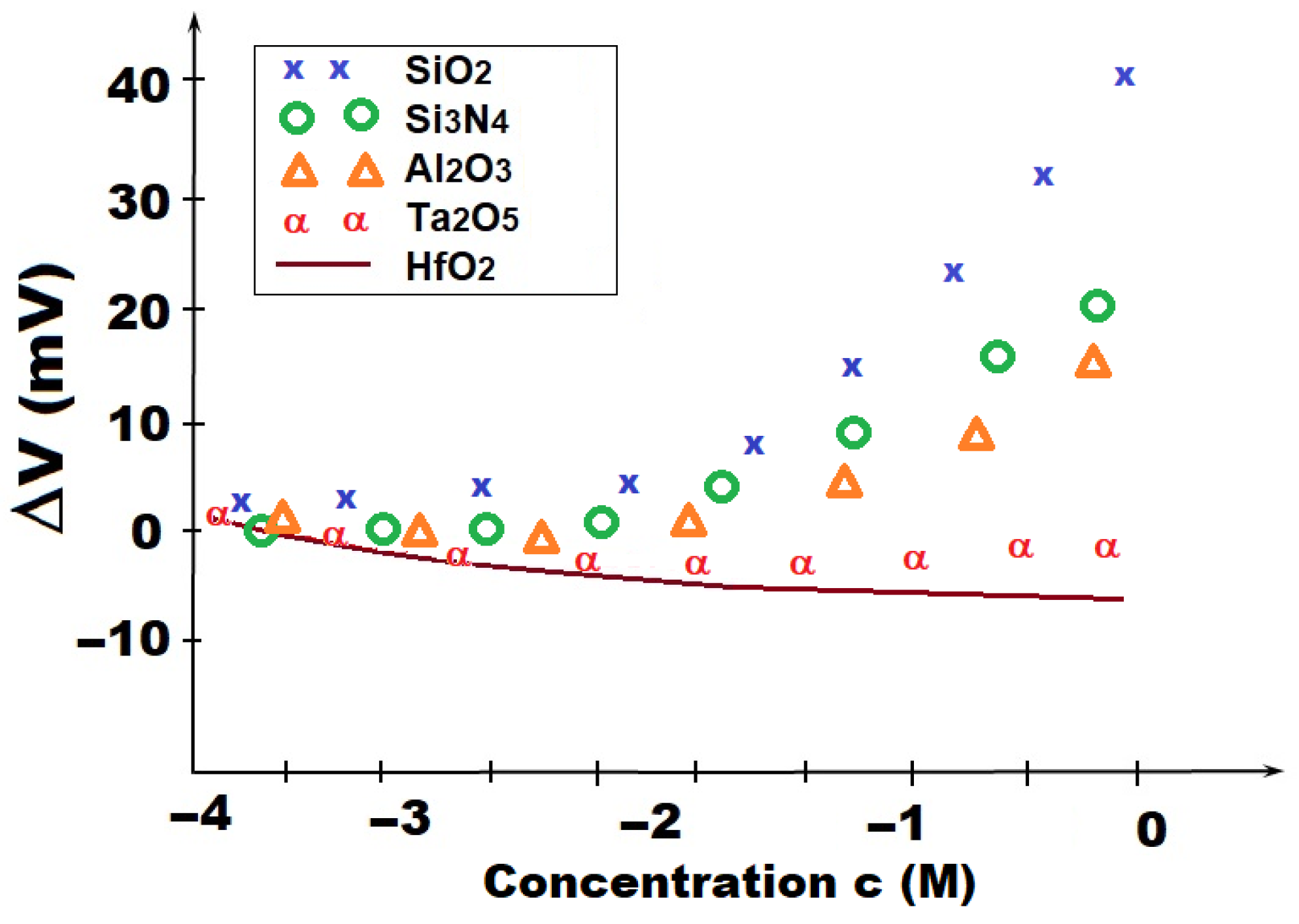
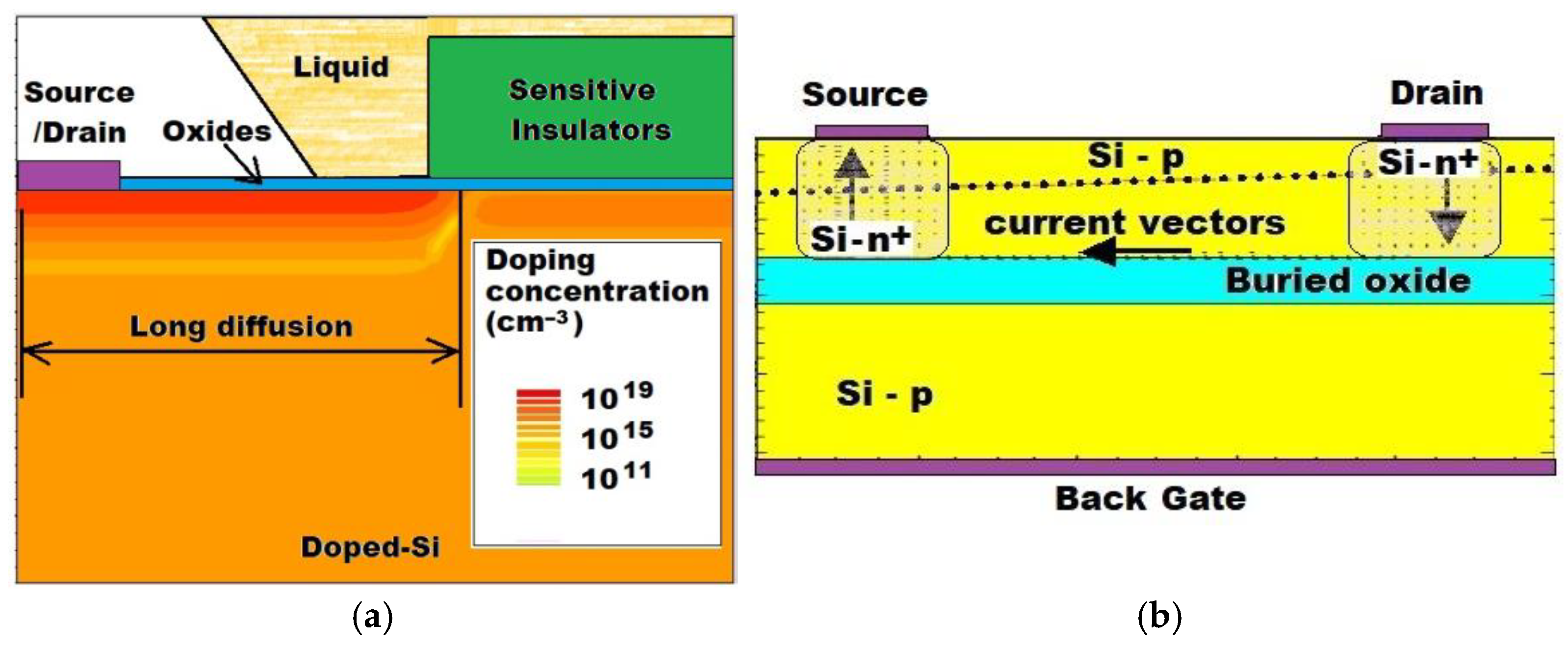
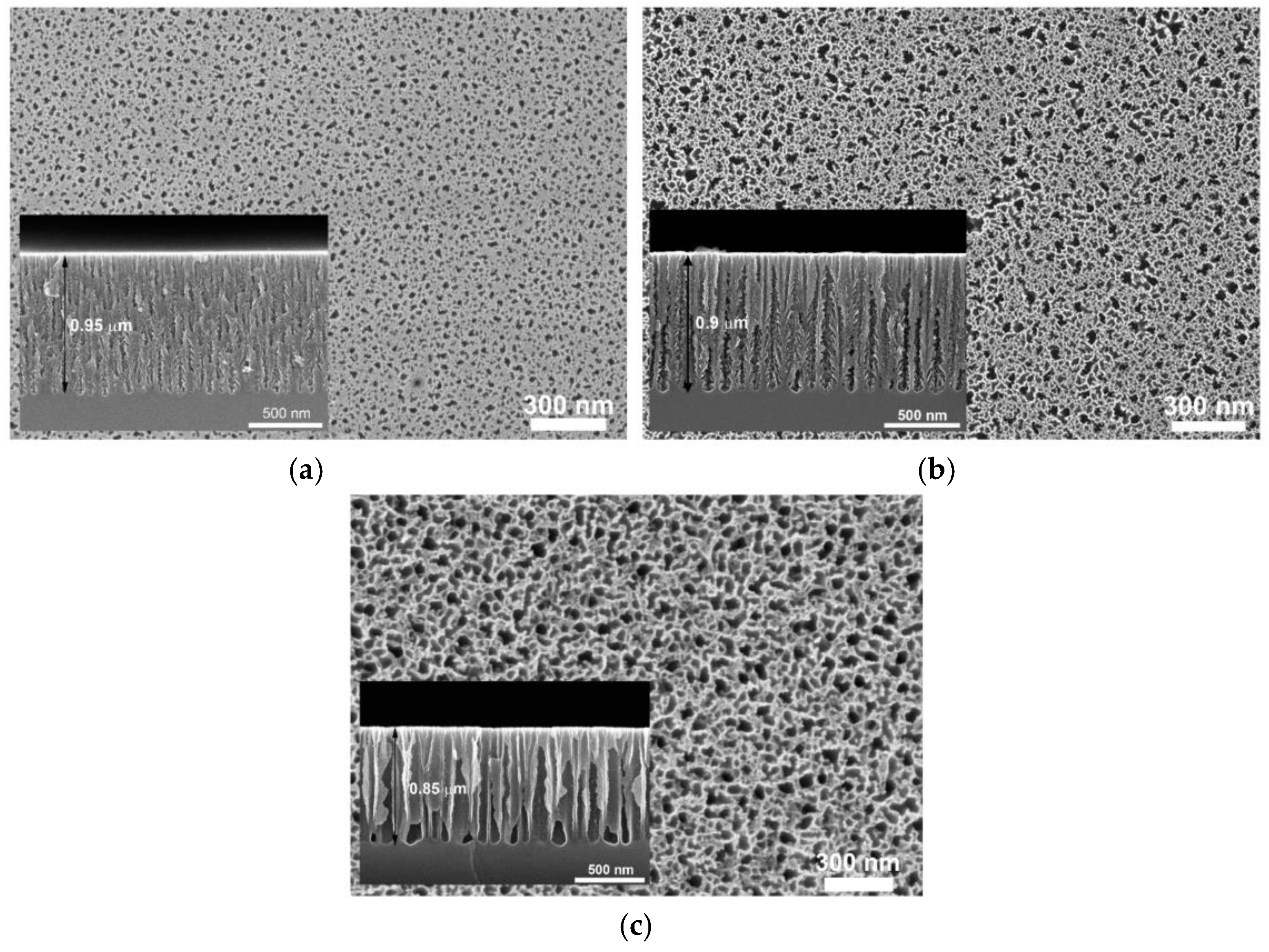


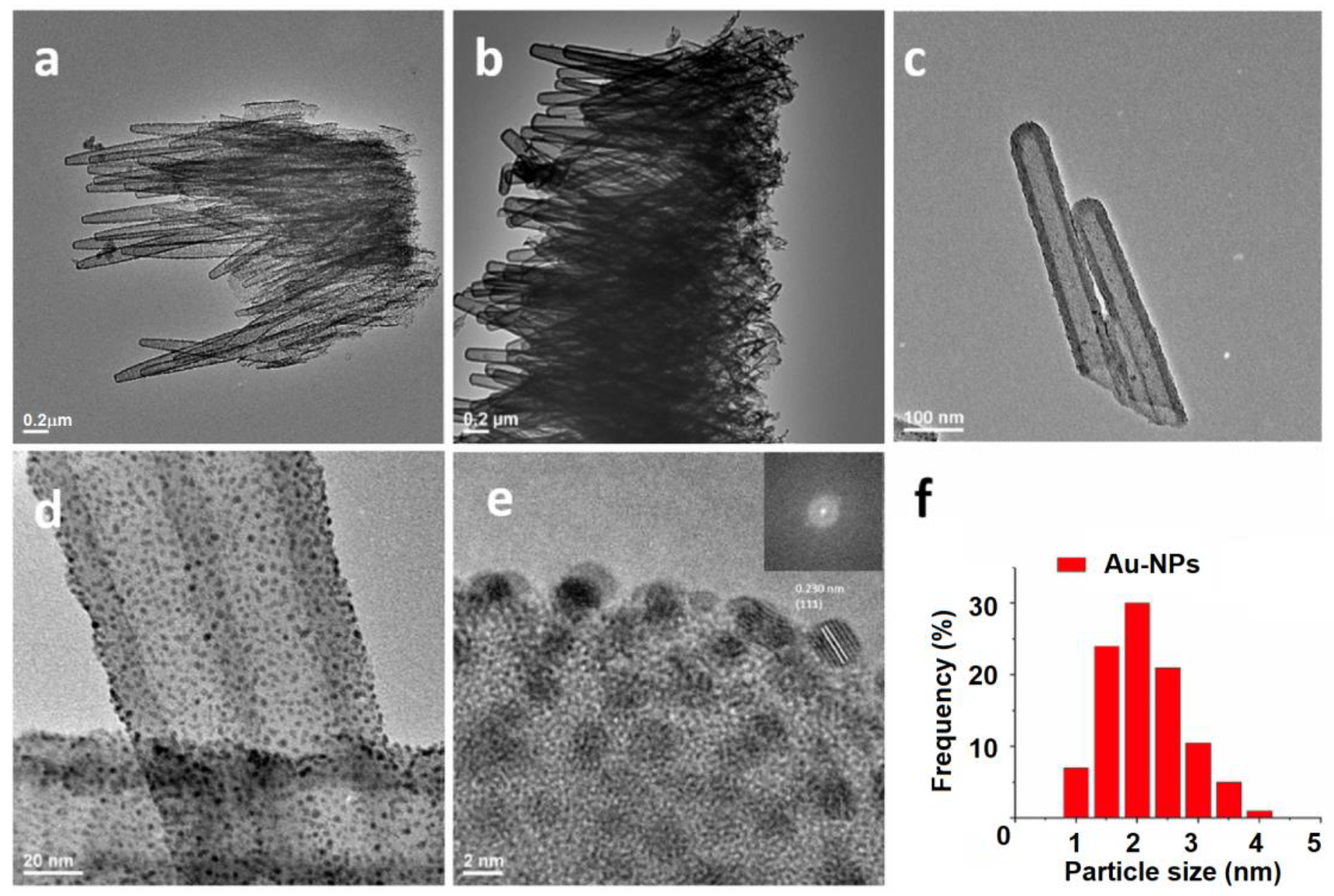
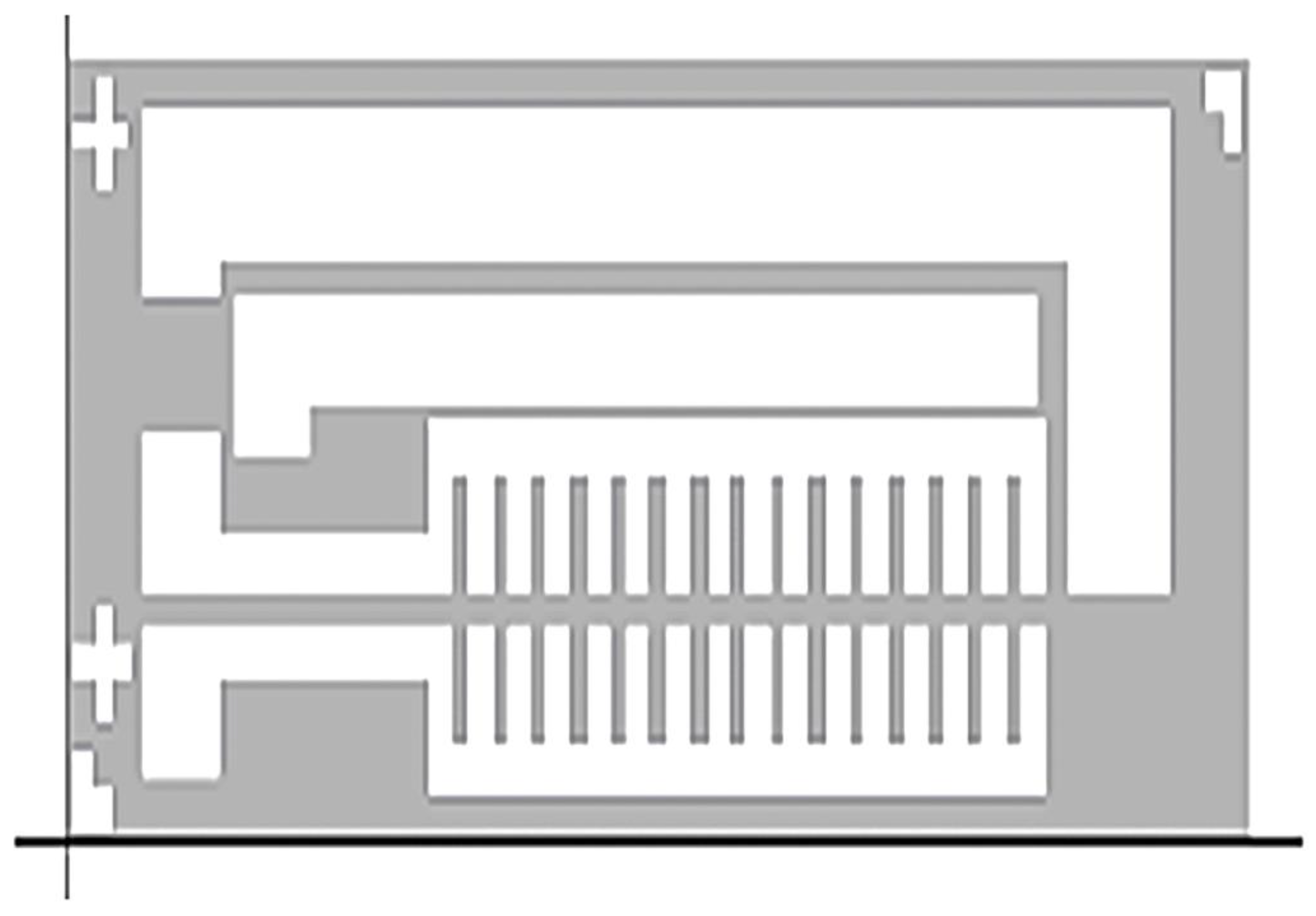


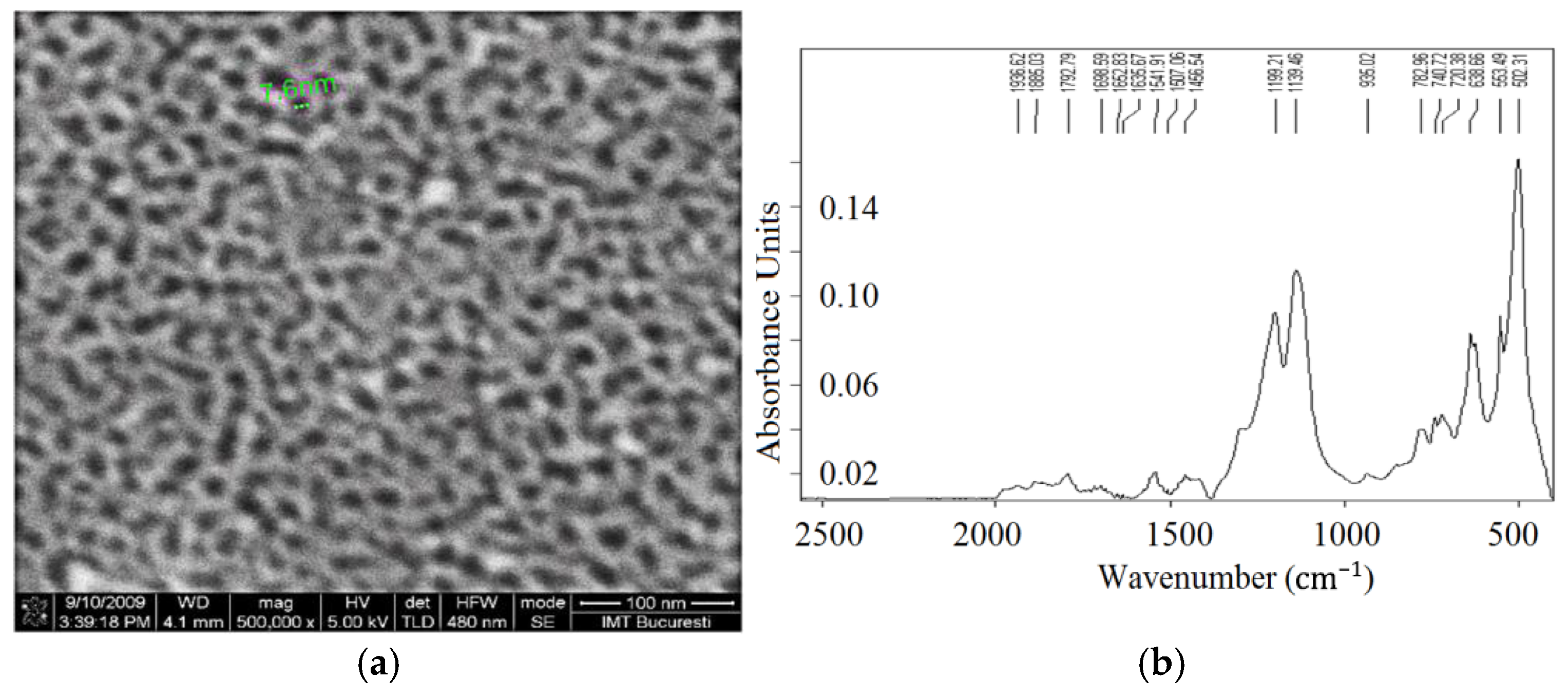

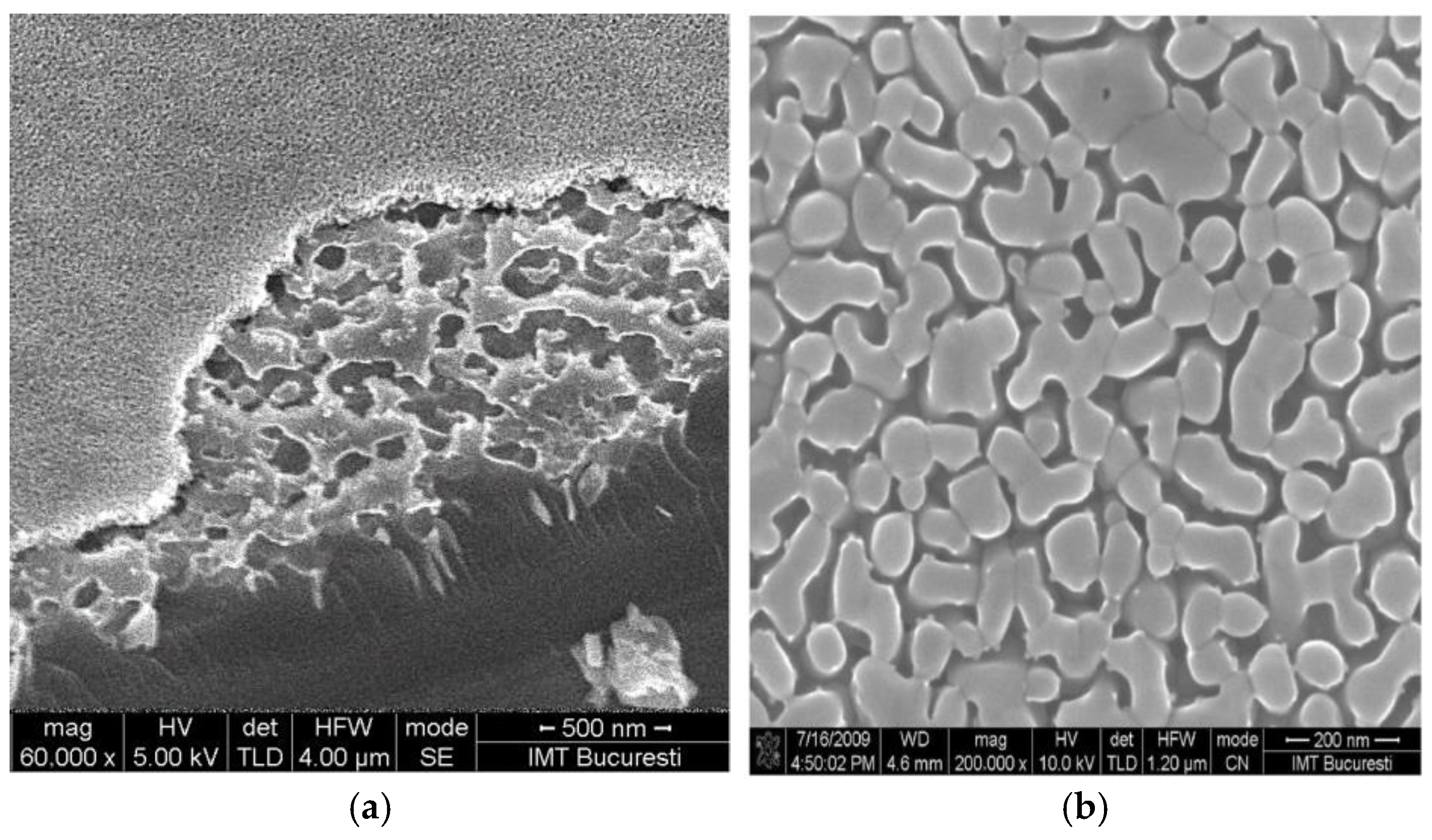
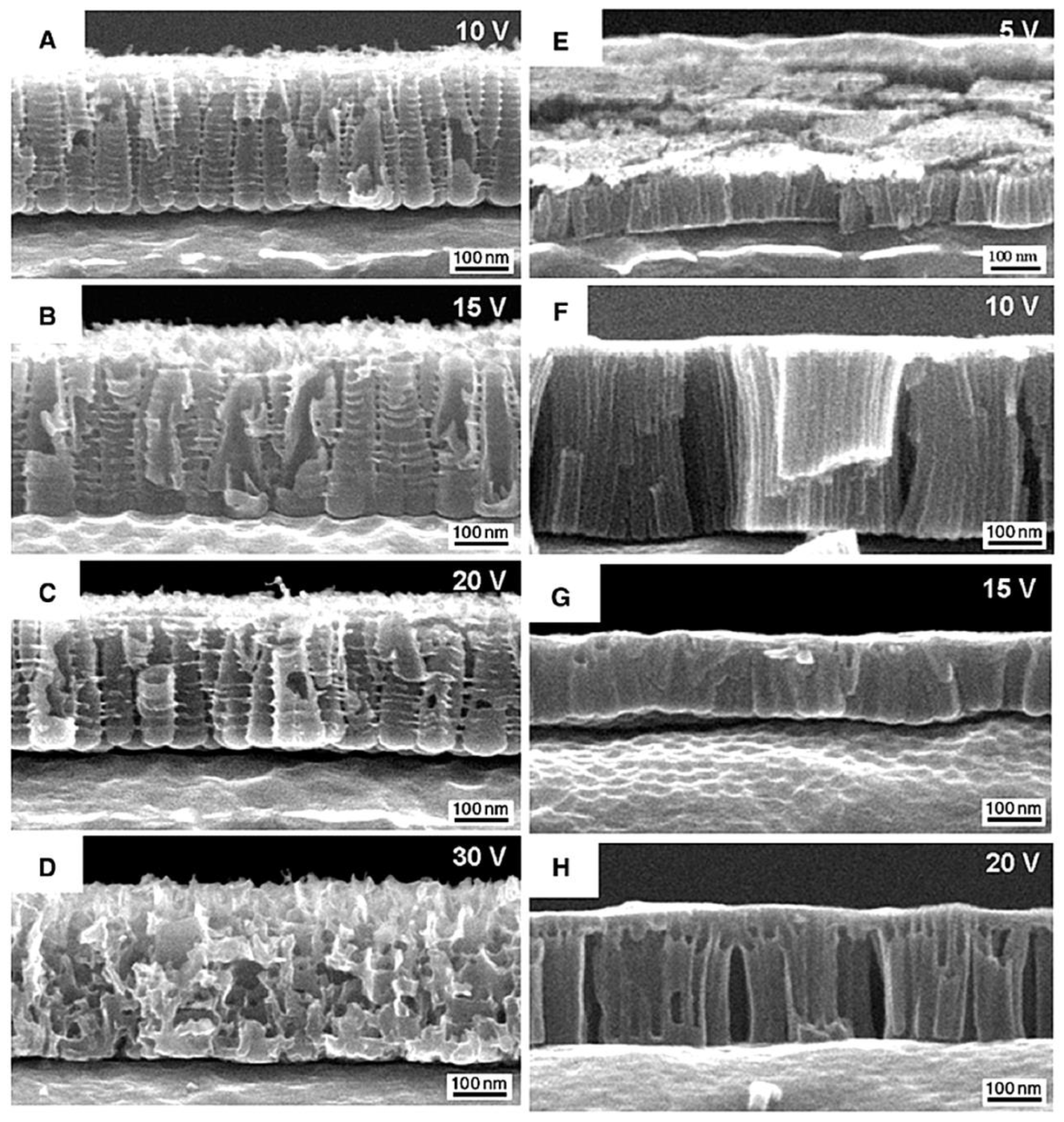

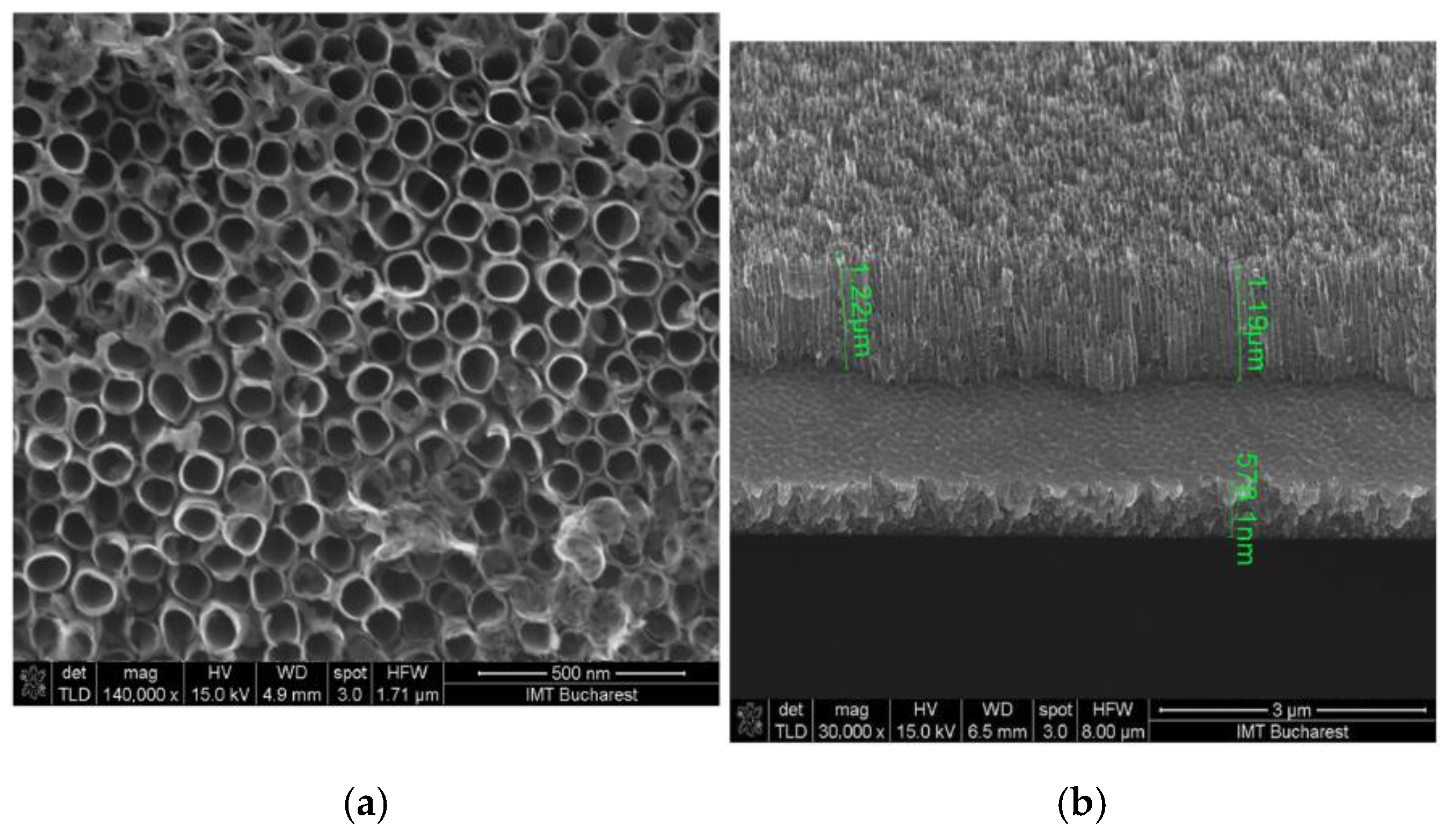





| Nanomaterial | Reported Year | Film Properties/ Specific Parameters | Technological Hints | Applications | Final Parameters/Limitations |
|---|---|---|---|---|---|
| PS (porous Si) | 2005 | Pores 1 ÷ 2 µm [60] | Anodizing HF: DMF | Human breath capacitive biosensor | 2.5 × 10−10 F/1 exhale, Time recovery = 20 min |
| 2007 | Pores 8 nm ÷ 2 µm [61] | Anodizing HF–Ethanol or HF:DMF | PV cells | Reflectance range 5–12% | |
| 2022 | Pores 2 ÷ 50 nm [62] | Anodizing HF in DMSO or isopropanol, PS at 8 mA/cm2 | Platforms for surface-enhanced Raman scattering (SERS) spectroscopy | SERS verifications for PS-based sensor at 1 uM dye rhodamine as analyte | |
| PSi-NTs (porous silicon nanotubes) | 2024 | Pores 20 ÷ 50 nm [65] | AuNPs functionalized to MPBA on PSi-NTs using ZnO seeds on Si wafer | Glucose biosensor, other SERS platform | Linear range 0.5 ÷ 80 mM, LOD = 0.5 mM |
| Nanostructured Al2O3 | 2010 | Nanoporous Al2O3 pores of few µm [21,69] | Anodization at 80 V, in electrolytes: (HCOO)2: H3PO4 | Glucose biosensor by GOX enzyme entrapping | Poor enzyme adherence |
| 2023 | Biomolecular binding on nanoporous MoS2 channel using Al2O3 grafting layer [70,71] | ALD of Al2O3 on MoS2 semiconductor | PSA biosensor | Excellent LOD of 1 fg/mL Expensive technology | |
| Nanostructured TiO2 | 2011 2017 | TiO2 pores of 7 ÷ 40 nm [36,76] | Ti deposition followed by anodization at 10 V in phosphoric acid mixed with oxalic acid | Glucose biosensor by GOX enzyme entrapping | Cross-linker is crucial for GOX immobilization; optimal TiO2 porosity for GOX 5 ÷ 50 nm |
| 2021 | TiO2 pores~20 nm [80] Post-anodizing annealing film at 500 ÷ 800 °C [39] | Technol. recommendations: avoid glycerol electrolyte [77] | Glucose biosensor by GOX enzyme entrapping | Linear range was 0.1 µM-1 µM if ISFET works in linear regime at VDS = 0.2 V; 0.001 mM-100 mM if ISFET works in saturation at VDS = 2 V [39] | |
| 2019 | TiO2 nano-flowers of 2 ÷ 10 µm size [78] | TiO2 was prepared on a fluorine-doped tin oxide as substrate, using precursor mixed in DI water, HCl, titanium(IV) n-butoxide [78] | pH sensor, ISFET-based with extended gate | Excellent linear range pH 2–12, with 99.91% linearity; sensitivity of 46 mV/pH | |
| Nanostructured vanadium oxide MnV2O6/GO | 2025 | 2D graphene oxide/manganese vanadium oxide nanocomposite synthesized via eco-friendly, microwave-assisted method [84] | MnV2O6/graphene oxide (GO) composite, nanosheet-like structure | Tailored for the photoelectrochemical (PEC) detection of glucose | Limit of detection, LOD of 0.13 µM for glucose |
Disclaimer/Publisher’s Note: The statements, opinions and data contained in all publications are solely those of the individual author(s) and contributor(s) and not of MDPI and/or the editor(s). MDPI and/or the editor(s) disclaim responsibility for any injury to people or property resulting from any ideas, methods, instructions or products referred to in the content. |
© 2025 by the authors. Licensee MDPI, Basel, Switzerland. This article is an open access article distributed under the terms and conditions of the Creative Commons Attribution (CC BY) license (https://creativecommons.org/licenses/by/4.0/).
Share and Cite
Ravariu, C.; Manea, E.; Pârvulescu, C.; Dima, G. Nanoporous Layer Integration for the Fabrication of ISFET and Related Transistor-Based Biosensors. Chemosensors 2025, 13, 316. https://doi.org/10.3390/chemosensors13080316
Ravariu C, Manea E, Pârvulescu C, Dima G. Nanoporous Layer Integration for the Fabrication of ISFET and Related Transistor-Based Biosensors. Chemosensors. 2025; 13(8):316. https://doi.org/10.3390/chemosensors13080316
Chicago/Turabian StyleRavariu, Cristian, Elena Manea, Cătălin Pârvulescu, and Gabriel Dima. 2025. "Nanoporous Layer Integration for the Fabrication of ISFET and Related Transistor-Based Biosensors" Chemosensors 13, no. 8: 316. https://doi.org/10.3390/chemosensors13080316
APA StyleRavariu, C., Manea, E., Pârvulescu, C., & Dima, G. (2025). Nanoporous Layer Integration for the Fabrication of ISFET and Related Transistor-Based Biosensors. Chemosensors, 13(8), 316. https://doi.org/10.3390/chemosensors13080316






